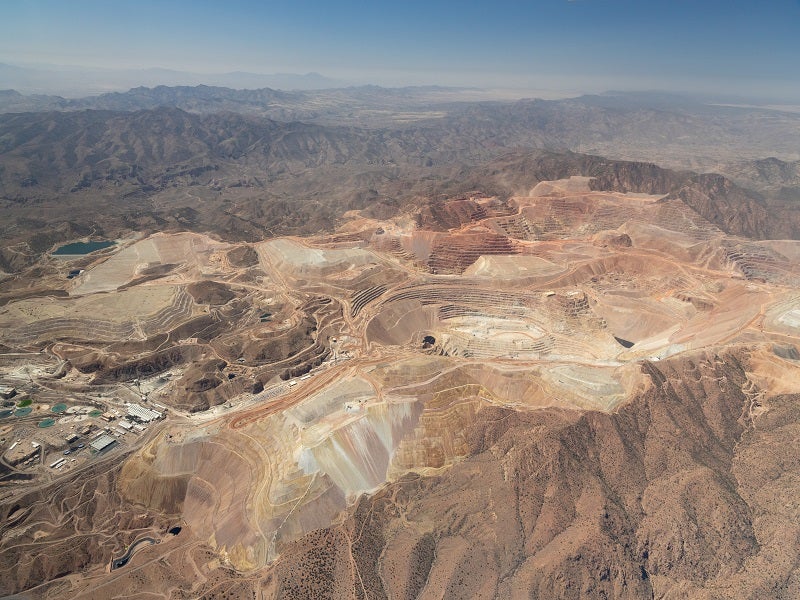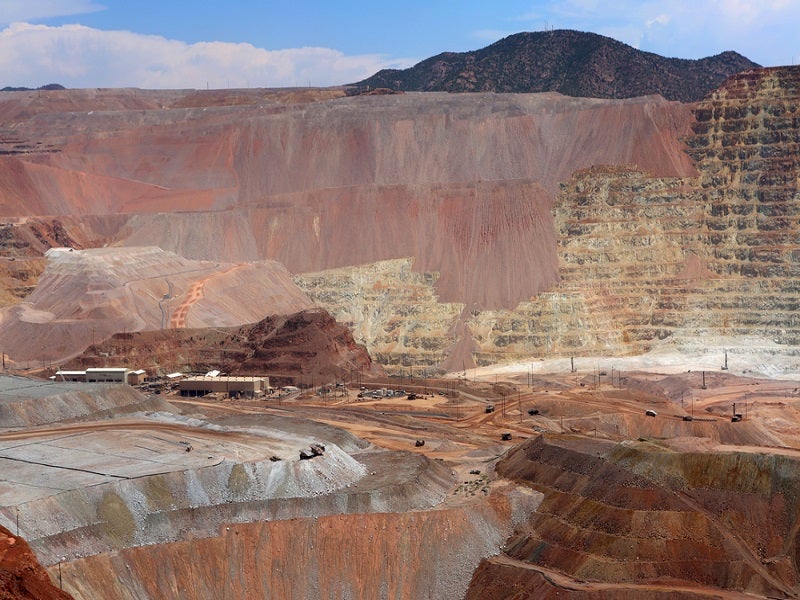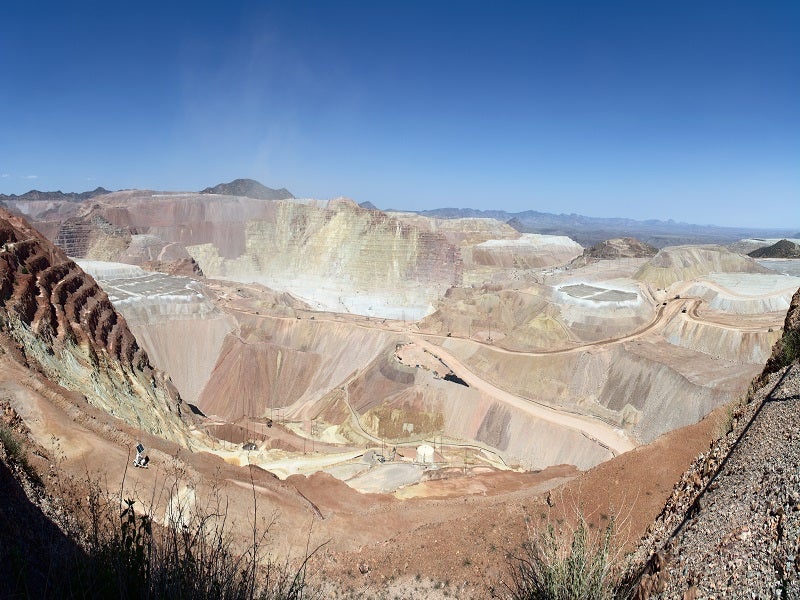The Morenci copper mine is located in Greenlee County, Arizona, in the southwestern part of the US. It is among the largest copper producers in North America.
US-based mining company Freeport-McMoRan operates the Morenci project. The company owns a 72% interest while the remaining 28% is held by Sumitomo Metal Mining’s subsidiaries Sumitomo Metal Mining Arizona (15%) and Sumitomo Metal Mining Morenci (13%).
Operations at the open-pit mine are expected to continue until 2041. The mine employs 1,706 personnel.
History of Morenci copper mine
The Detroit Copper Company started mining at Morenci in 1872. Copper Queen Consolidated Mining bought the property in 1885, with the company name changed to Phelps Dodge in 1917.
Phelps mined underground until the 1930s, converting to an open-cut operation with rail haulage in 1937.
Phelps Dodge merged with Freeport-McMoRan in a $25.9bn takeover by the latter in March 2007.
Freeport-McMoRan sold a 13% stake in the Morenci mine to Sumitomo Metal Mining in May 2016. The company’s principal asset is the large-scale Grasberg gold and copper mine in Indonesia.
Morenci project location
The Morenci copper mine is located approximately 80.4km north-east of Safford, Greenlee County, Arizona.
The mining property encompasses more than 61,700 acres comprising 51,300 acres of fee lands and 10,400 acres of unpatented mining claims.
Geology and mineralisation of the Morenci copper mine
Geological findings demonstrate that Tertiary igneous intrusive rocks were deposited within Precambrian-era granite and on top of sedimentary rocks of Palaeozoic and Mesozoic eras.
The porphyry copper deposit comprises copper oxide, secondary sulphide, and primary sulphide mineralisation.
Chrysocolla is the predominantly found oxide copper mineral while the most important secondary copper sulphide mineral is chalcocite. The dominant primary sulphide minerals found in the deposit are chalcopyrite and molybdenite.
The mineralisation extends 8km in a north-south direction and 6.43km in an east-west direction.
Reserves at Morenci
The proven and probable mineral reserves at Morenci were estimated at 12.3 million tonnes (mt) grading 0.23% copper, with 15,701 million pounds (mlb) of recoverable copper and 286mlb of molybdenum as of December 2022.
Mining at Morenci copper project
The Morenci mine employs a conventional open-pit, truck and shovel operation. The operation includes drilling, blasting, loading, and hauling.
The open pit mine is approximately 5.4km in width from east to west and 7.4km in length from north to south. The final pit depth is expected to be approximately 4,450ft, ranging from 1,800ft to 6,250ft above sea level. Mining operations are carried out on 50ft benches with double benches where the pit slope permits.
The current mining fleet includes 146 units of 267t trucks, 16 blast hole drills, 13 electric rope shovels and six front-end loaders. A fleet of ancillary equipment including track dozers, wheel loaders, motor graders, backhoes, and water trucks supports the mining fleet.
Processing at Morenci copper mine
Ore extracted from the Morenci mine is processed through hydrometallurgical or concentrating facilities. The hydrometallurgical process is used to produce high-quality copper cathodes while the concentrating facilities produce copper and molybdenum concentrates.
The hydrometallurgical process comprises crushed and run-of-mine (ROM) leach pads, stacking equipment, a concentrate leach plant (CLP), four solution extraction (SX) plants, and three electrowinning (EW) facilities to produce a high-quality copper cathode. The concentrating operation uses two concentrators and a molybdenum processing plant.
The hydrometallurgical process uses the SX/EW plant to extract copper. Primary and secondary sulphide ores are leached in leach pads to produce a pregnant leach solution (PLS), which is then transferred to the SX plant. A liquid ion exchange reagent causes the copper to transfer to the organic phase from the PLS while the barren raffinate from the SX plant is pumped to the leach pads to extract additional copper.
The loaded organic phase is transferred to a strip mixer-settler to transfer copper to an electrolyte. The electrolyte is filtered, heated and passed through the EW cells and plated onto stainless steel blanks, which are removed and washed once enough copper accumulates so the copper sheets can be mechanically harvested.
The concentrator processing method involves crushing the ROM in a primary, secondary, and tertiary cone crusher. The crushed ore undergoes grinding in 32 primary ball mills operating in closed circuits with spiral classifiers.
The finely crushed ore particles are transferred to a flotation circuit for copper and molybdenum recovery. The concentrates from the first stage flotation are transferred to regrind mills and cleaner flotation stages to produce an intermediate copper/molybdenum concentrate, which is thickened and fed to the copper/molybdenum separation flotation circuit.
A secondary crushing facility also processes ore for the Metcalf concentrator. The crushed ore feeds a tertiary hydraulic roll crusher (HRC), which feeds the primary ball mills. The fine ball mill product undergoes flotation to recover copper and molybdenum. Intermediate concentrates are also produced from the concentrates of the regrind mills and cleaner flotation.
The copper/molybdenum concentrate is thickened and combined with the Morenci concentrate and fed to the copper/molybdenum separation flotation circuit. The circuit produces separate marketable concentrates of copper and molybdenum.
Production plan details of the Morenci mine
The life of mine (LoM) plan calls for an increase in output to achieve an average mill production rate of 150,000 tonnes per day (tpd) of ore by 2024 and maintain it through 2036. The production rate is expected to decrease to an average of 90,000tpd during the final years of operation.
Freeport-McMoRan also aims to achieve an average daily crushed leach production rate of 90,000t of ore in 2023.
Infrastructure details
The paved route along US Highway 191 leads to the Morenci mine. The mine site is also linked to a railway line that supports the transportation of metal products and supplies.
A townsite at the operation features residential facilities, retail stores, restaurants, banks, schools, libraries, recreational facilities, and healthcare facilities.
The operation is supported by additional accommodation facilities for mine workers and supplies in Clifton, Tucson, Safford, and Phoenix, Arizona; and Silver City, Lordsburg, and Deming, New Mexico.
Freeport-McMoRan subsidiary Morenci Water and Electric Company (MW&E) provides electricity to meet the power demand for the operations. Natural gas-fired turbines with a total generation capacity of 24MW are also located on-site.
Water supply requirement is met from a series of sources including decreed surface water rights in the San Francisco River, Chase Creek, and Eagle Creek drainages.
Other sources include groundwater from the Upper Eagle Creek Wellfield and leased water from Central Arizona Project from the San Carlos Apache Tribe, which is delivered via exchange through the Black River Pump Station.
Water from the Lower Eagle Creek diversion and delivery system is used for the makeup water while potable and domestic water is sourced from the makeup water supply.
Contractors involved
Freeport-McMoRan engaged full-service electrical contractor Spectra Electrical Services in 2013 for the construction of a new electrical distribution building (EDB), branch power distribution, controls and lighting systems for the main tailings pump station, seepage pond sites and the tailings dam material handling automation equipment.
Wastewater treatment solutions company Evoqua Water Technologies was contracted in 2018 to construct a 347 gallons-per-minute water treatment facility for the mine.






